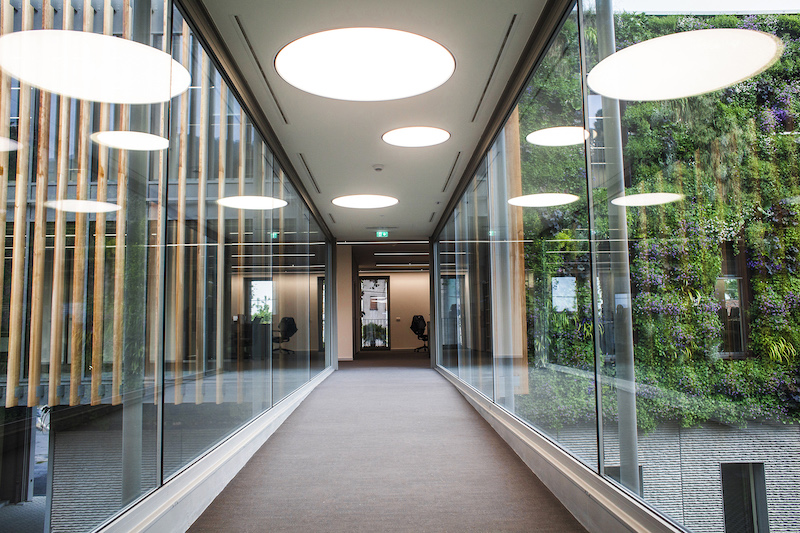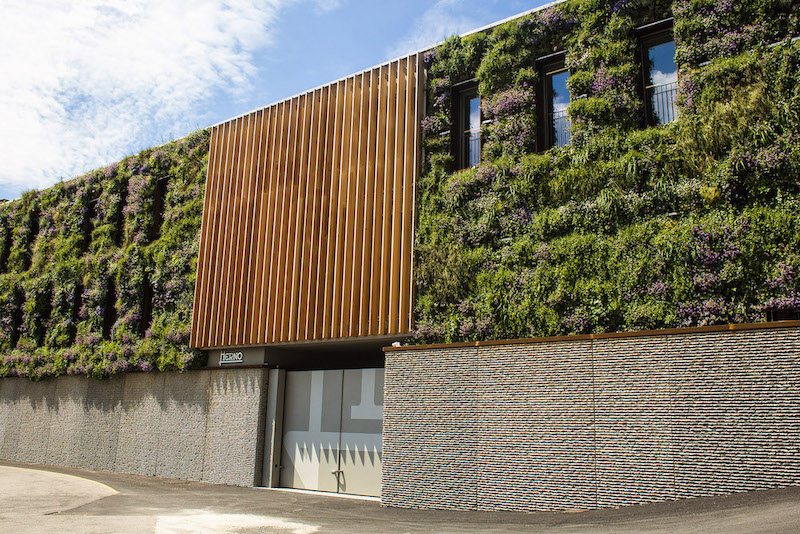Just minutes from the famed shores of Lake Maggiore, on the Piedmont side in Northern Italy, stands the headquarters of Herno. The luxury outerwear company was named for the river it resides beside, the Erno, which flows into the lake just in the distance. Whitewall visited the manufacture, a short drive from Milan, last fall just before the leaves started to change, ushering in autumn. There, a modern facility built in natural stone and wood is filled with windows overlooking a region rich with green plants and wildlife—forest, water, mountains, and weather. A living wall, seasonally blooming in grasses or wildflowers complemented Herno’s signature “H” logo, welcoming teams of artisans and visitors like us.
Touring the Area that Inspired the Heart of Herno
On the overcast, slightly foggy day we visited, it was clear to see how this area of Northern Italy originally inspired the founding of Herno. The Italian company began with a spark of innovation in 1948 when Giuseppe Marenzi and his wife, Alessandra Diana, created a raincoat from cotton treated with castor oil. This bit of postwar Italy experimentation led to a line of functional jackets and high-performance raincoats. By the mid-1950s, Herno’s production grew to include women’s garments, with the following decades seeing expansion into Japan (in 1968) and the United States (in the 1980s).
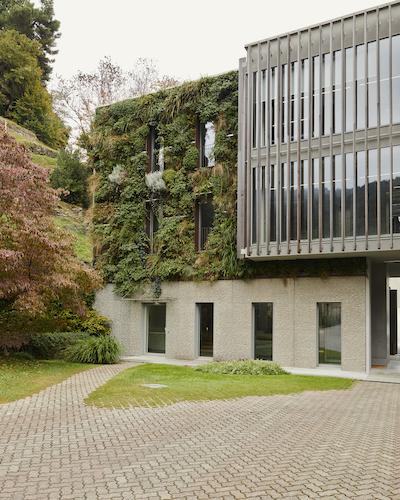
Herno’s Manufacture, photo by Ablerto Zanetti.
Herno is Synonymous with Made-in-Italy
Herno became synonymous with high-performance outerwear complemented by Italian craftsmanship, garnering the attention and business of high-fashion labels, producing coats and jackets for houses like Armani, Prada, Louis Vuitton, Hermès, Gucci, and more. In the 1990s and early 2000s, as brands started taking production in-house, Herno, under the leadership of second-generation family member Claudio Marenzi, decided to focus inward and make Herno a household name known for its superior quality and material know-how.
Committed to the region that inspired its founding, Marenzi chose to keep Herno on the shores of Lake Maggiore, expanding not only production and brand recognition globally, but focusing on a future that was inherently sustainable. Long before “going green” was a staple conversation in the worlds of luxury and fashion, Marenzi implemented self-sufficient energy goals, production chain studies, carbon footprint assessments, plastic-free initiatives, and various certifications. It was a challenge for both the manufacture and its partners, but one that was met with enthusiasm, even spilling over into material innovation, integrating fabrics like Fast5Degradable, regenerated Econyl nylon, recycled wool, and more into its latest collections.

Claudio Marenzi, photo by Ablerto Zanetti.
Herno’s Claudio Marenzi is Inspired by Art
Visiting Herno’s headquarters, it was clear how the site’s surrounding natural landscape has provided endless inspiration. Within the manufacture, displays of contemporary art in its hallways, rooms, and near Marenzi’s office offered another spark of creativity. Indeed, Marenzi shared with us that he began collecting art as soon as he could afford it in high school, hanging a first picture on the back of his door. It’s clear that he shares an understanding of artists, of their vision, their passion, their desire to make. Organizing exhibitions, show locations, and even assisting in helping artists find financing for different projects at a younger age, he has grown his collection to include work where it’s clear the artist has a singular perception.
Within Herno’s manufacture, works by women artists like Susan Jackson and Latifa Echakhch are on view, energizing Herno’s team of mostly female employees. Marenzi’s interest in art extends beyond his own collection, to commissions from artists like Asako Narahashi, Pae White, and Massimo Kaufmann, as well as partnerships with art fairs like miart for the Herno Prize.
After a tour of Herno’s stunning campus, Whitewall sat down with Marenzi to learn more about the family company’s heritage and clear vision for what’s next.
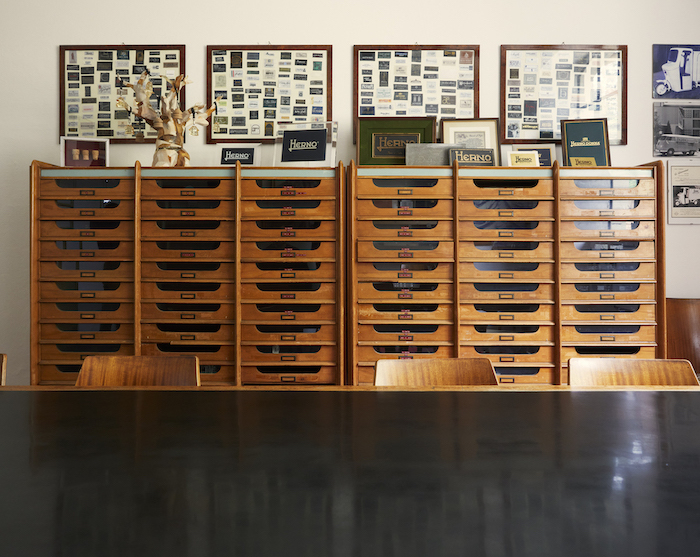
Herno’s Manufacture, photo by Ablerto Zanetti.
WHITEWALL: What was it like growing up with the family business of Herno?
CLAUDIO MARENZI: During my summer vacations in high school, I always worked in the company. I liked going to the cutting room, in the style department, and the logistics. So, after high school and university, I started to work in the company, and I fell in love with this job. I became an operations guy. I started with the pattern maker, the procedure, the operations, and it was this great chance at the end of the eighties to work directly with the designers. I learned so many things working with these great designers, about their organization, to build up my idea of the business.
WW: What made you ultimately decide to carry on the family company?
CM: What I realized before 2005 was the things that we could make very well—the raincoats, the double face—we could not sell with our own brands. In that period, we were making for other brands. But we had the know-how to do something special. So this really pushed me to go in this direction. Because, for me, the family is the company, the company is the family.
I wanted to protect a vision my father had in 1948 when he was 20 years old. It’s always been about what relates us to the region, to the past, to our roots.
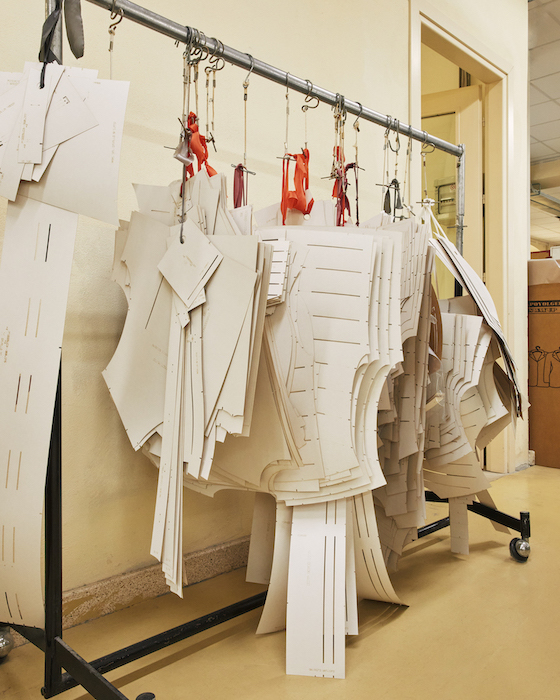
Herno’s Manufacture, photo by Ablerto Zanetti.
New Beginnings for Herno, Under the Leadership of Claudio Marenzi
WW: How have Herno’s roots in innovation remained a driving force for you?
CM: In 2005, I said, if we are making raincoats, we are making something that has a function, to keep people dry from rain and water. We are making something functional. Functionality is related to performance. So our mission should be to improve functionality, and therefore performance. Performance is about innovation so the innovation at the end should be our mission.
Beginning in 2007 and 2008, we made the down jacket with the injection down, coats that were both light and warm. We started to work with materials from different fields in fashion and active wear. In 2016 we launched, after one year of research, a complete collection in GORE-TEX, Herno Laminar.
When you produce something new, you don’t think only about the aesthetic. You should ask, “Why am I doing it? What’s the reason?” And related to all this is sustainability. Because you have to do something that is better than before, but why?
Because the function is better, it’s easier to recycle, meaning it’s very important, in my opinion, to know what we want to do.
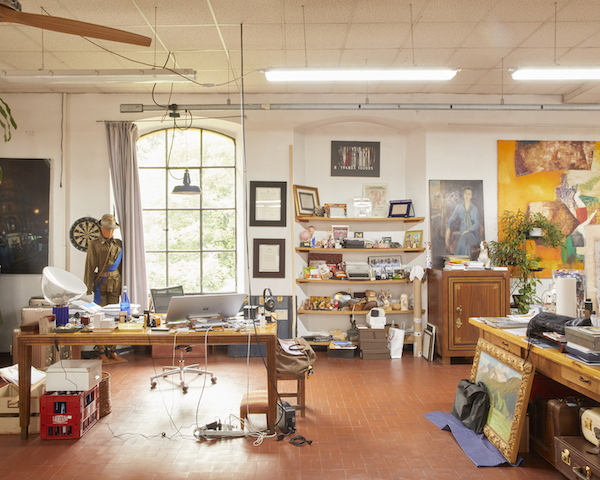
Herno’s Manufacture, photo by Ablerto Zanetti.
An Art Collection That Inspires
WW: Walking around the manufacture we could see contemporary art from your collection on its walls in different locations. How did your interest in art begin?
CM: My interest began in secondary school. I’ve always had an admiration for the people who are able to draw or create with their hands. The first picture that I bought was when I was 15, 16, with the small money my father gave from working. It was on the door of my room. The artist was local here, and it started like that.
Then I met the artists of my generation in Italy, like Stefano Arienti, Alessandro Pessoli, Massimo Kaufmann, and Maurizio Cattelan. I even organized, for some of them, some exhibitions. In my twenties and thirties, I would help artists find financers. And still today, I always invest in art.
WW: How has your collection continued to grow?
CM: At the beginning, for me, it was about passion. Everything is about passion. And then at a certain point, when the collection began to grow, it was clear it needed a direction. I wanted to build a sense of aesthetics and harmony at a certain point.
I have one point—whether it’s pictures, video, installation, or any piece of art, it must be something extraordinary and new. You should understand that the artist is somebody who is able to do something that others cannot. I need to feel the Holy Spirit over the artist. The artist is someone who is doing something we cannot do.
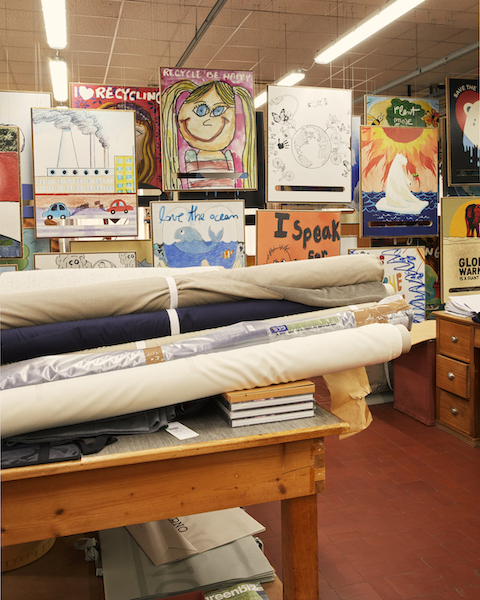
Herno’s Manufacture, photo by Ablerto Zanetti.
WW: Why did you want to bring that collection inside the manufacture?
CM: At the beginning, it was by chance. I spent so much time in the company, I thought, “Why not treat it like a home?” And then the reaction of the people here was nice. More or less 80 percent of the total employees here are women, so there is now a through-line of most art from women artists like Andrea Bowers, Latifa Echakhch, and Susan Jackson.
WW: You’ve collaborated with artists like Asako Narahashi to capture Lake Maggiore for the brand. What do you enjoy about connecting artists with Herno, that collaboration?
CM: I was impressed by her pictures of Mount Fuji, so I wondered what she could capture of our lake, her perspective of Lake Maggiore. Japan was our first international market, so in our 70th anniversary book, we dedicated a section to Japan, and I took the occasion to invite a Japanese artist to interpret our lake and company. She took these pictures of the lake, the landscape, the Erno River as a kind of tribute to Japan.
Herno Supports the Arts
WW: Are you interested in collaborating with artists in the future?
CM: We’ve collaborated with Stefano Arienti in our showroom. For another presentation we collaborated with Pae White. And then we have another great collaboration with Massimo Kaufmann with an intention to do more in the future.
WW: What’s a piece you’ve recently acquired that you’re excited about?
CM: Six months ago, I met Susan Jackson. She is an incredible artist, full of life and spirit, and we talked for many hours at her exhibition. In the end, I bought one of her pieces. Hearing her thoughts, about her life, she impressed me quite a lot.
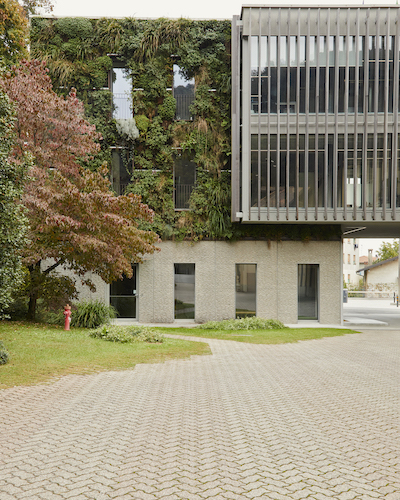
Herno’s Manufacture, photo by Ablerto Zanetti.
WW: Is there an exhibition you’ve seen recently you’re still thinking about?
CM: In Italy, there was a very nice exhibition of Nicolas Party. I have one of his wonderful wall paintings in the company. He did it more or less 15 years ago. It was one of the first works realized directly in the company. It was at the beginning of his career. Now, it would be impossible. I saw his exhibition in Milan a couple of months ago and was very happy to meet him again.
WW: Sustainability has been at the core of the brand, long before other brands adopted a sustainable approach. Why has that been key for you?
CM: We are based on Lake Maggiore, for me one of the best places in the world. So I want to keep it! Everything starts with our territory. In some way, I think the sustainability is something like a healthy selfishness. Meaning, if you try to keep your garden perfect, and in this case sustainable, then your neighborhood will do the same. Eventually, the whole street will be clean and sustainable. So, in 2010 we turned our factories to renewable energy where the energy that we produced is the energy that we consume.
Then inside the company, like with the art, we began a virtual path around sustainability. We started to draw attention to sustainability. This is something that drove us to three years later, in 2013, start thinking of our production environmental footprint. Then we made a dedicated capsule collection called “Globe.” That’s how it began.
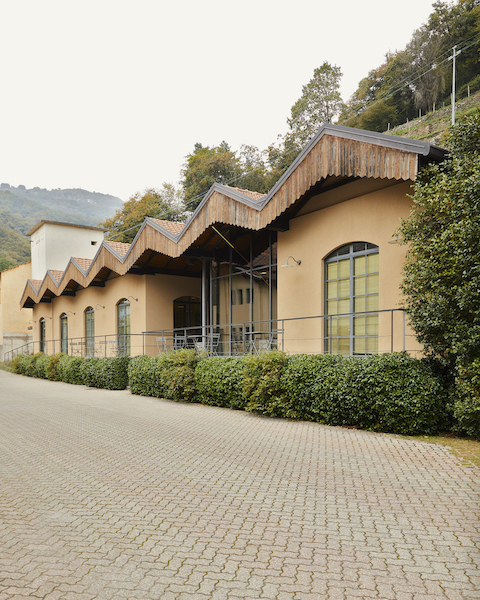
Herno’s Manufacture, photo by Ablerto Zanetti.
Herno Embraces Sustainability
WW: You’ve said, “Sustainability is not just a certification or about communication. We have to change chemical materials and industrial procedures.” Can you tell us more about why that is key and how we see that in the latest Herno innovations?
CM: Innovation means even making innovative fabrics. We push our suppliers to create new fabrics. For example, we use a nylon that biodegrades in the absence of oxygen in just five years instead of fifty for some of our down jackets. This kind of innovation is something that is in our DNA.
WW: We read that often, instead of taking lunch, you go on a bike ride around the region. How does the territory of Herno’s home continue to inspire you?
CM: Yes, during lunch or in the summer evenings before dinner I bicycle to the lake or the mountains. For me, it’s easy to concentrate, I can relax, and many ideas come from this kind of short bike ride. It’s something that really inspires me.






